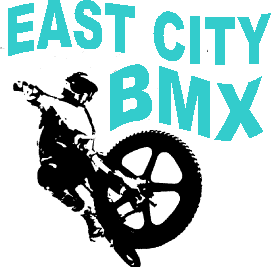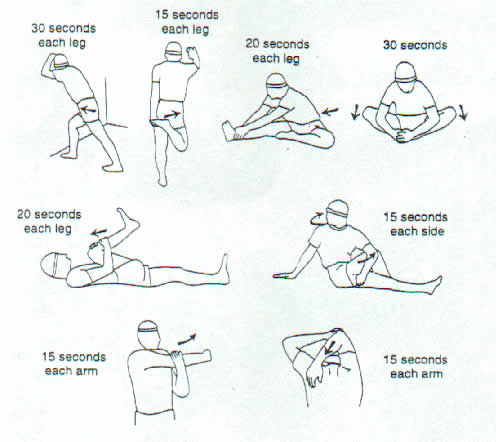
Address: Merton Road Reserve
Entrance off Howard Hunter Avenue, St Johns
Email Us
Goal Setting | Season Breakdown | Training Outline | Stretching
Training And Tips
Welcome to our page on tips. This page will change often so do remember to check back.
If you have any questions you would like answered then please email us and we will endeavor to get
them answered. It is our pleasure to introduce you to the person who will be providing you with your tips
and that person is.........Richard McLachlan. We will now hand you over to Richard.
GATE STARTS
The start is the most important part of any BMX race. It's also the hardest.
Getting the "Holeshot" takes the most strength, the most mental concentration
and the most nerve.
Starting stanceStart with your pedals in line with level ground then adjust to counter for the
angle of the ramp (higher for steeper gates - lower for flatter gates).Your bike must be straight onto the gate, so that you can make a straight
exit down the starting ramp.Riders back should be straight, hips over the back wheel, head up and looking
forwards, shoulders wide. Elbows and legs should be slightly bent.Hands should project vertically from the tops of the grips.
TimingThe ideal is for the rider to go as the gate drops. To help, the rider should
i) Move the hips and upper body back
ii) Begin moving prior to the snapping action
iii) Move forward keeping the shoulders still and stamping on the leading foot
in preparation for the snap.
The SnapOne you have developed the timing of the gate start, the next step is to work
on "The Snap".
The rider must throw their weight (hips and shoulders) forward into the front
of the bike. The head and shoulders must stay forward for the first pedal to
generate maximum power with the first pedal. The rider Should pull the first
pedal backwards as far as possible (as close to nine o'clock as possible) to
help with a smooth transition to the second pedal. The body weight should be
moved backwards for the third and subsequent pedals, to allow a good
cranking rhythm to develop as soon as possible
Welcome to the new season of BMX racing.Firstly for those who do not know me, I will give you a bit of background, before I talk about the
upcoming season. I have been racing for over 15 years and still enjoy BMX. I have achieved
many goals over the years and these are listed below for you.
Goals Achieved
- To be New Zealand's number one rider Done
- To be the only person to have two number
one plates in elite men Done- Last season's goal was to be the only rider
in elite men to get the number one plate two years
in a row. Done
Now you the rider need to sort some things out. First your need to set some goals for the season.
- Short term goals
- Long term goals
- Seasonal plan
- Training cycles
A short term goal is like North Island champs that are coming up.
What training are you going to do before this race?
What results do you want to achieve at this meeting
Top five
Make the final
Or maybe just get around the track without crashing.
Write down these goals now (pen on paper).
Long term goals are what you want to achieve this season 2002/2003 and then the
2003/2004 season and then 2004/2005 season.
Write these down too, but next to them write how you are going to do this.
What skills do you need to work on, or what fitness levels you need to reach.
(strengths and weakness). This is a plan for most riders 8 years and over who want to do well.
If you are under 8 years then just have fun, this is the best thing you can do.
Season Break Down
In a season there are 3 periods
Pre Season - July, August, September, which is general fitness and specific fitness base.
In Season - October to March, focusing on power work, refine techniques, maintain or
increase fitness.
Off Season - April to June, rest, recreation and rehabilitate.
Peaking For Major Events
Many BMX riders will start training two weeks out from an event in an attempt to peak for
that particular event. Two weeks prior to a major event is the time a well prepared athlete
will begin to taper the training work load down. This is so they may be fresh for competition.
A good foundation of high volumes of work in the pre season, then decreasing the volume
and increasing the intensity of training and refining the skills of BMX over the in season will
help you the rider peak for a race like the New Zealand Champs.
If you go up to the track for some training here is an idea of how to spread the time spend
on your bike. (better than riding around and gaining nothing)
Warm up (that is easy riding) 10mins and stretches
Speed/Power work 20 mins
Skill Development 40 mins
Fitness work 10 mins
Cool down (easy riding again) 10 mins and stretches. The stretches are important
Total training time of one and a half hours. You don't really notice the time, it goes fast
when you are training right. Well this will get you worked up for the season. In latter months
I will go through things like gate starts, jumping, speed jumping and cornering. Stay tuned
every month for updates.
Richard Mclachlan
#One Elite Men
Stretches
Hold the stretch, do not bounce for the time required, 10 seconds, counting elephants is a good way to make
sure that you don't count too fast. That is one elephant, two elephant, three elephant and so on.
Never stretch cold, always warm up first. Stretching prepares your body for what is to come
ahead. Allow your body to tell you how far you can stretch. As time goes on and the more
time you spend stretching you will be able to stretch further, but don't push it. If you are unsure
on how this is done, then ask an adult how. If you skip this part of training then you are not taking
care of your body and you will pay for it in later years.
Home | BMXer Needs | Training Tips | Club Information | Bike Bits | Links | Map | National Results | Outside Events | Newsletter | Photo Gallery | Fliers
Ted's Web Design© 2003

